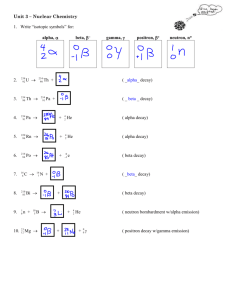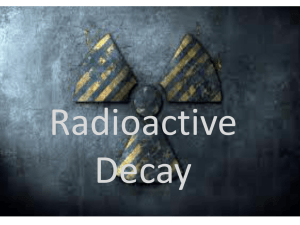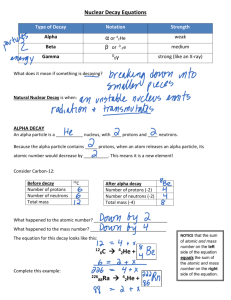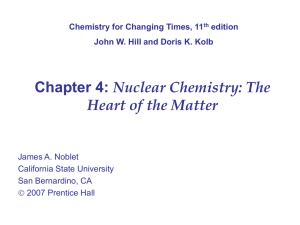What makes a nucleus Stable
advertisement
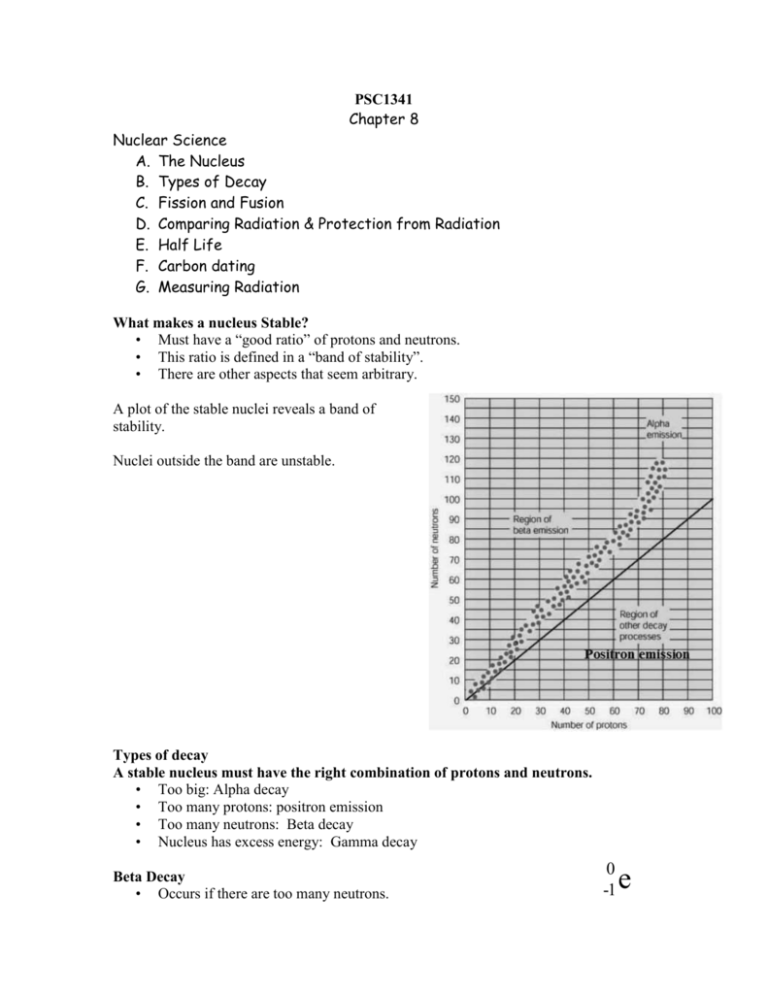
PSC1341 Chapter 8 Nuclear Science A. The Nucleus B. Types of Decay C. Fission and Fusion D. Comparing Radiation & Protection from Radiation E. Half Life F. Carbon dating G. Measuring Radiation What makes a nucleus Stable? • Must have a “good ratio” of protons and neutrons. • This ratio is defined in a “band of stability”. • There are other aspects that seem arbitrary. A plot of the stable nuclei reveals a band of stability. Nuclei outside the band are unstable. Types of decay A stable nucleus must have the right combination of protons and neutrons. • Too big: Alpha decay • Too many protons: positron emission • Too many neutrons: Beta decay • Nucleus has excess energy: Gamma decay Beta Decay • Occurs if there are too many neutrons. 0 -1 e • • A neutron to proton conversion occurs. This releases an electron or beta particle. Carbon-14 undergoes beta decay to the stable nitrogen-14 isotope. Balancing Nuclear Equations • Sum of top numbers on the left must equal sum of top numbers on right. • Same thing for bottom numbers.(Check the C-14 example) 0 e 1 Positron Emission • Isotopes on the lower side of the band of stability might want to turn a proton into a neutron through positron emission. • A positron is essentially a positive electron. 4 Alpha Decay 2 He • Large isotopes that need to decrease their size tend to decay by alpha emission. • An alpha particle can be described as a helium nucleus, , 2 protons and 2 neutrons. 238 92 U Uranium Decay Th 42 He 234 90 Gamma Decay () • The gamma ray is not a particle it is part of the electromagnetic spectrum. • Gamma radiation occurs when a nucleus has excess energy. • Some nuclei can exist for a little while with excess energy. These are called metastable isotopes. Technetium 99 has a meta-stable isotope. • A gamma ray can be represented by . Technetium-99 has a meta-stable isotope. Tc 99 m 43 Tc γ 99 43 Top: 99=99 Bottom: 43= 43 Technetium-99 is used in medical applications. It comes from Molybdenum-99. The Molybdenum-99 undergoes a beta elimination producing a meta-stable Technetium-99 Fission and Fusion • Nuclear Fission involves the breaking up of large nuclei to smaller nuclei. link • Nuclear Fusion is the energy-producing process, which takes place continuously in the sun and stars. In the core of the sun at temperatures of 10-15 million degrees Celsius, Hydrogen is converted to Helium providing enough energy to sustain life on earth. Nuclear fission of U-235 1 0 n + 235 92 U 139 56 Ba + 94 36 Kr + 3 01 n Types of Radiation Stopped by Damage to Cells Alpha almost anything. example: paper Most Damage Beta wood, heavy clothing, plastic Gamma lead, concrete Least Damage Protect yourself by… • Minimizing time of exposure • Distance • Shielding Half Life • The half-life of a radioisotope is the time it takes for one half of a sample to decay. • Iodine-131 has a half-life of 8 days. Days Amount of 131I 0 8 16 24 40 20 10 5 32 40 2.5 1.25 Decay of Iodine-131 Grams of I-131 The decay of an isotope is not linear 45 40 35 30 25 20 15 10 5 0 0 10 20 30 Days 40 50 Carbon Dating An archeologist extracts a sample of carbon from an ancient ax handle and finds that it emits an average of 10 beta emissions per minute. She finds that the same mass of carbon from a living tree emits 40 beta particles per minute. Knowing that the half life of carbon-14 is 5730 years, she concludes that the age of the ax handle is? Measuring radiation • Curie :the amount of any radionuclide that undergoes 37 billion atomic transformations a second. • A nanocurie is one one-billionth of a curie. • A Becquerel is one disintegration per second. • 37 Becquerel, = 1 nanocurie • The curie is proportional to the number of disintegrations per second. RAD • RAD (radiation absorbed dose) measures the amount of energy actually absorbed by a material, such as human tissue • Takes into account the absorbing material. (Bone may absorb better then skin or muscle). REM • Rem (roentgen equivalent man) measures the biological damage of radiation. • REM=RAD*RBE – RBE (relative biological effect) takes into account that alpha particles are 10 X more damaging than beta particles. • LD50 = 500 rems Homework 1. What is the symbol used to describe an alpha particle in nuclear reactions? (A) 4 He (B) 0 e (C) 0 e (D) (E) 1 1 2 2. Which type of radiation has no mass and no charge associated with it. (A) alpha (B) beta (C) gamma (D) -none of the above. (E) All of the above. 3. Which type of radiation has the least penetrating power? (A) alpha (B) beta (C) gamma (D) none of the above. (E) All of the above. 4. Cobalt -60 has a half life of 11 minutes. At 11:00 am the doctor has 20 mg, how much is left if you arrive at 11:22? (A) 20 mg. (B) 10 mg. (C) 5 mg. (D) 2.5 mg. (E) 0 mg. 5. Which of the following measures not only amount of radiation absorbed but also the biological effect of the radiation. (A) Curie. (B) RAD. (C) REM. (D) Becquerel. (E) None of the answers A-D 6. Gamma rays have the same basic nature as a) alpha particles b) beta particles c) x-rays d) sound waves 7. Cobalt-60 decomposes by emitting a particle. What is the element and mass number of the other product of this decomposition? 8. Plutonium-238 decomposes by emitting a particle. What is the element and mass number of the other product of this decomposition? Answers: 1. A 2. C 3. A 4. C (At 11:11 there would be 10 mg, at 11:22 there would be 5.0 mg) 5. C 6. C 7. Nickel-60 8. Uranium-234



